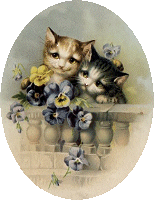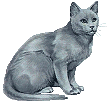











|





 





|
|

It has been 5000 years since man domesticated the cat. The first cat made tame was the African Wildcat. The cat wasn't domesticated to make a pet or companion; the cat was domesticated by accident. In the Valley of the Nile (which is now Sudan, but then was Upper Egypt), the cat was first domesticated. The people in Egypt at that time consumed large amounts of grain, and they stored this grain in large storage rooms. Many rats would draw to these rooms to eat the grain and breed. The rats attracted cats who would eat the rats, thus helping to eliminate Egypt's rodent problem. People recognized this fact and left food out for the cats to encourage them to "hang around." It worked. Many cats bred and lived happy lives in Egypt destroying the plentiful rats. Now the Pharoah had much grain that needed protection from vermin. He wanted to consficate all of the cats in Egypt and keep them near the palace graineries, but he couldn't. Cats were so popular among his people that to remove all the cats from all the people in Egypt would have caused a revolt. So, instead he cleverly declared all cats "demigods." This means that they weren't gods equal to the Pharoah's status, but they certainly were more valuable than the average person. With this plan, people could care for the demigods (cats) while they remained the official property of the Pharoah. The status of the cat shot up overnight. If anyone killed a cat, they were sentenced to death. If a house caught on fire, the cats were pulled to safety first. If a cat died of natural causes, the family had to bring the dead animal to the priest to make certain the cat's death was natural. People would sob for their cat with outwardly displays of sorrow. Shaving their eyebrows or beating their chest was a good sign of this sadness.

Cats spread to other parts of the world by ship. The crew members would always keep extra cats aboard the ship to kill any mice that might be aboard. Cats spread quickly, and soon were part of many religious beliefs and dieties. One such goddess, Freya, a Norse goddess during the middle ages, had the head of a cat and the body of a woman. The inclusion of cats with religious gods became the cat's downfall. When Christianity spread, it condemned false gods, and cats were viewed as a manifestation of the devil. This led to 100 years of pure torture to the cat. Many were killed, tormented, burned at a stake, or else roasted alive. Consequently, the cat population declined tremendously, and cats became scarce. It is supposed that domestication of cats took place not only in Egypt but in other regions on the globe. The remains of animals discovered when excavating the ancient settlements of the Bronze Age and even late Stone Age on the territory of the Caucasus, Central Asia, India confirm this idea. At the beginning of AD a cat as a domestic animal, appeared in Roman Empire and according to Plutarchus, in I century AD, it was found in Europe. In the XIth century domestic cat spread over the whole Europe and became an ordinary domestic animal used in household first of all for catching rodents. At the same time the spreading took place in Russia. According to excavations cats come to us not only from the west but also from the south. There were discovered the remains dating from the VIIth-VIIIth centuries AD in the south of Ukraine, and in central and northern regions of Russia (Moscow, Novgorod) - dating from the Xth-XIVth centuries. Cat become the favorite domestic animal because of its features and habits, very specific, different from the features of other domestic animals: meowing resembling the crying of the child during the heat, changes of pupils of the eyes depending on the power of light, soft, noiseless step etc. And simultaneously it was chased and driven away. In convents cat was the only animal allowed to keep. In the Xth century in Great Britain cats were worshiped; for theft or killing of the cat one could be sentenced to death. In other countries, in France, for example, at the same time cats was considered to be a Satan, a monster. Often the owners of black cats were accused of agreement with a devil. In the Middle Ages many people were burnt with their cats. That's why in the ancient pictures cats are depicted together with the warlocks. The same image of this animal one can find in fairy-tales, but absurd and invented superstitions about cats have fallen into oblivion. In other countries where Islam ruled, cats were held in respect. The legend says that Mohammed adored cats. When one of them was sleeping on his sleeve and he had to go out, Mohammed supposedly cut off the sleeve not to disturb his pet. The cat was also common in China by 500 BC. At first the cat was given as gifts to Emperors. As time went by the nobility were allowed to own them, then the priesthood, and finally the commoners. A lot of the cats interbreed with the local wild cats and created some of the breeds we know today. The fluffy Persian came from the country of its name. Now called Iran. The Angora from Turkey. The Siamese from Siam, now Thailand. The Burmese from Burma, now Myanmar and the Bobtail from Japan. In Japan, cats are seen as lucky. One of the most known cat is the 'Beckoning Cat'. This cat is seen with one paw held up, and brings good luck to Japanese and Chinese homes and businesses that have one displayed. The story goes that a cat used to stand out the front of the Gotokuji Temple in Tokyo and hold up its paw and beckon people in. Due to the cat the temple became very rich. The temple still exists today and cat lovers go there to pray for the good health of there pets. In Europe the cat was seen as evil and disciples of the Devil. By 1400 the cat was almost extinct due to bad press from the Church. This was because the Church felt that the cat had to much connection to Pagan churches and beliefs. This is one of the main reasons that The Plague got out of hand. At first the People thought that cats and dogs were the bringers of plague. This led to the anilination of both animals. Later it was discovered that there was less of a problem with plague if there was a lot of cats around. This encouraged people to start keeping cats again.
    
 Please read our Legal Statement and Privacy Policy.
|